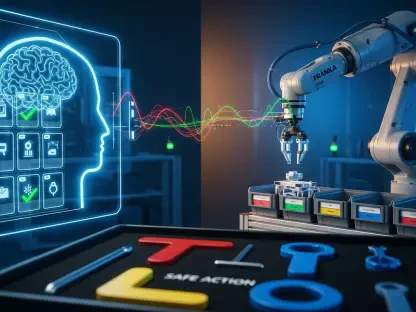In the evolving landscape of artificial intelligence, few voices resonate with the depth and foresight of Laurent Giraid’s. As a seasoned technologist, his insights into machine learning, natural language processing, and ethical considerations surrounding AI lend a comprehensive view of the ongoing partnership between OpenAI and Microsoft. In this interview, we delve into the shifting dynamics of their collaboration against the backdrop of OpenAI’s IPO ambitions and its broader implications for the sector.
Can you explain the current discussions between Microsoft and OpenAI regarding their partnership renegotiation?
The renegotiation primarily revolves around aligning both companies’ future goals as they navigate the rapidly advancing AI sector. OpenAI is contemplating an IPO while restructuring into a for-profit model, which necessitates rethinking the existing deal with Microsoft to better serve this aim. Microsoft, on the other hand, is eager to ensure extended access to OpenAI’s advancing AI technology beyond the initial terms, reflecting a shift from equity to prolonged tech collaboration.
What are OpenAI’s main goals as it considers an IPO?
As OpenAI eyes a public offering, its primary goal is to secure enough capital to continue pioneering in AI innovation while remaining faithful to its mission of benefiting humanity. It seeks to solidify its financial and operational foundations by potentially adopting a Public Benefit Corporation structure, allowing it to balance profit pursuits with its original altruistic mission.
How does Microsoft’s long-term access to OpenAI’s technology play into their discussions?
Microsoft’s focus on long-term tech access is crucial in the discussions because it represents a strategic pivot from holding financial equity to securing operational leverage. By prioritizing continued integration of OpenAI’s models, Microsoft aims to sustain its competitive edge in AI applications, thus underlining the significance of future model access over mere ownership.
Why is OpenAI considering restructuring into a more traditional for-profit entity?
The restructuring reflects OpenAI’s need to attract investment in the face of increasing financial demands for cutting-edge AI development. While the nonprofit model has served its mission-driven objectives, transitioning to a for-profit entity provides a path to an IPO, thereby unlocking the capital necessary for expansive projects like AGI.
How much equity has Microsoft invested in OpenAI to date, and what is its significance in the current talks?
Microsoft has invested over $13 billion in OpenAI, a substantial figure that underscores its vested interest in the partnership. The existing equity impacts how negotiations unfold, as both companies weigh exchanging equity for technological access, highlighting potential shifts in ownership stakes versus operational priorities.
In what ways have OpenAI’s ambitions expanded since the partnership with Microsoft began in 2019?
Since initiating their collaboration, OpenAI’s ambitions have scaled significantly beyond initial research objectives. The company increasingly focuses on direct market engagement and diversifying its technological impact across sectors, reinforcing its influence in AI and boosting independence and innovation capacity.
What are Microsoft’s primary interests in its partnership with OpenAI beyond equity?
Microsoft’s interests are deeply rooted in maintaining technological relevance and leadership in AI enablement by utilizing OpenAI’s models within its enterprise solutions. It seeks to optimize its investments by ensuring long-term access to next-gen AI models to enhance its product offerings and uphold its competitive enterprise applications.
What does it mean for Microsoft to secure extended access to OpenAI’s future AI models?
Securing extended access means Microsoft can continually embed the latest AI advancements into their platforms, ensuring sustained innovation without being tethered to ownership complexities. It allows Microsoft to focus on strengthening its AI infrastructure and application ecosystem while benefitting from OpenAI’s pioneering work.
How has Microsoft integrated OpenAI’s technology into its products so far?
Microsoft has seamlessly incorporated OpenAI’s technology across a range of its products, from Bing search enhancements to integrated solutions within Office applications. This integration elevates Microsoft’s AI capabilities, positioning it as an AI frontrunner through strategic application of generative models.
Are there any potential challenges for Microsoft in reducing its equity in OpenAI for prolonged tech access?
The challenge lies in navigating the regulatory and investment landscape, ensuring any equity reduction aligns with strategic growth without compromising Microsoft’s influence and rewards from past investments. Furthermore, reducing equity while maintaining tech access involves complex negotiations to protect shareholder interests and support operational ambitions.
How does OpenAI’s transformation illustrate the tension between its original mission and commercial realities?
OpenAI’s transformation highlights the dichotomy between its foundational aim of AGI for humanity’s benefit and the necessity to embrace commercial mechanisms to sustain and scale innovation. It must balance the ethical imperatives of its mission with pragmatic financial strategies to thrive amid competitive pressures.
What implications does OpenAI’s potential transition to a Public Benefit Corporation (PBC) have?
Transitioning to a PBC could allow OpenAI to formalize its commitment to social goals alongside profit-making. This model may better encapsulate OpenAI’s mission, offering greater governance transparency and ethical accountability while potentially influencing broader industry standards for responsible AI development.
How has OpenAI been building independence from Microsoft?
OpenAI has advanced its independence by cultivating direct enterprise relationships and developing its computing infrastructure, Stargate, with partners like SoftBank and Oracle. These efforts extend OpenAI’s reach and autonomy, enabling it to expand its technological ecosystem beyond the Microsoft anchor.
What are OpenAI’s plans for its own computing infrastructure?
OpenAI plans to strengthen its computing infrastructure by collaborating with technology leaders to enhance computational capacity through projects like Stargate. This infrastructure aims to foster more robust autonomous operations and cater to diverse computational requirements essential for AGI research advancement.
How might Microsoft’s diversification beyond OpenAI benefit its AI initiatives?
Diversifying beyond OpenAI allows Microsoft to hedge its bets by integrating various AI models and technologies, enhancing its Copilot capabilities. This strategy not only broadens choice for enterprise clients but also reduces dependency on single-source innovation, fostering agility and resilience in its AI solutions.
Why is regulatory scrutiny from entities like Delaware’s attorney-general relevant in these discussions?
Regulatory scrutiny ensures that OpenAI’s structural transformations honor nonprofit governance norms, preventing any dilution of control over the mission-driven entity. Such oversight is vital to safeguard ethical commitments and maintain public trust amid the complex legal and business implications of their restructuring.
What are the potential long-term impacts of the OpenAI and Microsoft partnership renegotiation on the AI sector?
The renegotiation could set a precedent for balancing mission-driven goals with commercial viability in AI, influencing how other tech partnerships evolve. It showcases potential paths for structuring sustainable collaborations that emphasize technological access and ethical governance alongside financial interests.
What challenges could OpenAI face in balancing investor trust with its mission to develop AGI?
OpenAI confronts the challenge of aligning investor expectations with long-term goals like AGI, whose fruition is uncertain and ethically sensitive. Balancing immediate revenue and operational needs with the pursuit of ambitious, mission-centered objectives demands strategic foresight and transparent governance.
How does OpenAI’s focus on accountability and transparency influence its growth strategies?
Emphasizing accountability and transparency aligns OpenAI’s growth strategies with ethical AI principles, fostering stakeholder trust. It positions OpenAI to lead advocacy for responsible AI development, balancing profit with societal impacts, which is crucial as the sector faces scrutiny over safety and fairness.
What role does ethical governance play in the viability of OpenAI’s future projects?
Ethical governance is central to ensuring OpenAI’s projects align with its mission of AGI for humanity’s benefit while navigating commercial realities. By prioritizing ethics, OpenAI reinforces its credibility and sustainability, essential for undertaking ambitious projects that bear profound societal implications.
Do you have any advice for our readers?
My advice for readers is to stay informed and critically engage with the ethical dimensions of AI advancements. As these technologies become increasingly integral to society, understanding their implications and advocating for responsible development will be crucial in steering their impact toward beneficial outcomes for all.









